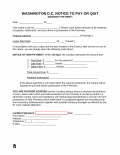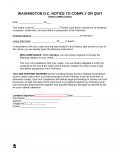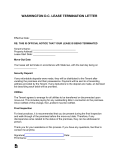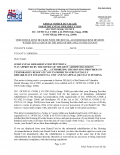Updated April 11, 2024
A Washington D.C. eviction notice is a legal document that a landlord uses to notify a tenant that they are violating a term on the lease and must fix the issue within a specified number of days. Violations can range from failing to pay rent to engaging in illegal activity.
By Type (9)
 30-Day Notice to Quit (Non-Payment of Rent) – Notifies tenants that unless they pay all owed rent within 30 days of receiving this notice, the landlord may initiate the eviction process. 30-Day Notice to Quit (Non-Payment of Rent) – Notifies tenants that unless they pay all owed rent within 30 days of receiving this notice, the landlord may initiate the eviction process.
Download: PDF, Microsoft Word, OpenDocument |
 30-Day Notice to Quit (Non-Compliance) – Gives tenants 30 days to fix some violation of the lease agreement other than non-payment of rent. 30-Day Notice to Quit (Non-Compliance) – Gives tenants 30 days to fix some violation of the lease agreement other than non-payment of rent.
Download: PDF, Microsoft Word, OpenDocument |
 30-Day Notice to Quit (Month-to-Month Tenancy) – Both tenants and landlords may end a month-to-month tenancy by providing the other party with 30 days’ notice. 30-Day Notice to Quit (Month-to-Month Tenancy) – Both tenants and landlords may end a month-to-month tenancy by providing the other party with 30 days’ notice.
Download: PDF, Microsoft Word, OpenDocument |
 30-Day Notice to Quit (Illegal Activity) – When the tenant commits an illegal act on the premises. 30-Day Notice to Quit (Illegal Activity) – When the tenant commits an illegal act on the premises.
Download: PDF, Microsoft Word, OpenDocument |
 90-Day Notice to Quit (Personal Use and Occupancy) – When the landlord decides to use the property for their own personal use. 90-Day Notice to Quit (Personal Use and Occupancy) – When the landlord decides to use the property for their own personal use.
Download: PDF |
 90-Day Notice to Quit (Personal Use and Occupancy of a Contract Purchaser) – Also known as RAD Form 13, In the event that a landlord intends to sell the property and has identified a buyer. 90-Day Notice to Quit (Personal Use and Occupancy of a Contract Purchaser) – Also known as RAD Form 13, In the event that a landlord intends to sell the property and has identified a buyer.
Download: PDF |
 120-Day Notice to Quit (Substantial Rehabilitation) – Also known as RAD Form 16, if a landlord wants to perform improvements that are so substantial that it is impossible for the tenant to live on the premises. 120-Day Notice to Quit (Substantial Rehabilitation) – Also known as RAD Form 16, if a landlord wants to perform improvements that are so substantial that it is impossible for the tenant to live on the premises.
Download: PDF |
 180-Day Notice to Quit (Notice of Demolition) – Also known as RAD Form 15, to be used if the landlord intends to demolish a structure on the property where the tenant resides. 180-Day Notice to Quit (Notice of Demolition) – Also known as RAD Form 15, to be used if the landlord intends to demolish a structure on the property where the tenant resides.
Download: PDF |
 180-Day Notice to Quit (Discontinuance of Housing Use) – Also known as RAD Form 17, if the landlord no longer intends to use the property for residential purposes. 180-Day Notice to Quit (Discontinuance of Housing Use) – Also known as RAD Form 17, if the landlord no longer intends to use the property for residential purposes.
Download: PDF |
Table of Contents |
Eviction Laws
- Rent Grace Period: 5 days.[1]
- Non-Payment of Rent: 30 days.[2]
- Non-Compliance: 30 days.[3]
- Termination (Month-to-Month): 30 days.[4]
- Illegal Activity: 30 days.[5]
- Personal Use and Occupancy: 90 days.[6]
- Personal Use and Occupancy of a Contract Purchaser: 90 days.[7]
- Substantial Rehabilitation: 120 days.[8]
- Notice of Demolition: 180 days.[9]
- Discontinuance of Housing Use: 180 days.[10]
- Eviction Lawsuit: Evictions.[11]
Prohibited Landlord Actions
Utility Shutoff – While no statute explicitly states that a landlord may not interrupt a tenant’s utility services, this act is considered a self-help eviction and considered illegal.
Changing the Locks – While no statute explicitly states that a landlord may not change the locks to block a tenant’s access to their unit, this act is considered a self-help eviction and considered illegal.
Court Forms
Answer of Defendant – Those facing eviction may use this form to respond to a notice to quit.
Complaint for Nonpayment of Rent (Form 1-A) – A landlord may file this form with the court to begin the eviction process if the tenant has failed to pay rent.
How to Evict a Tenant (4 steps)
2. File Complaint with Local Court
If the necessary notice period for the type of eviction has elapsed and the tenant remains on the premises, the landlord should file the complaint, Form 1-A, with the Landlord and Tenant Branch of the Civil Court Division.
The initial filing fee is $15.[12]
4. Attend Hearing

A judge in the landlord and tenant branch will set a date for a hearing. Landlord and tenant matters in the District may be handled either by an attorney or by the party involved, which is known as “pro se.”
Both parties are obligated to appear and may present evidence and arguments. Landlords should expect additional procedural requirements if the tenant being evicted receives public assistance or is in the process of applying.


